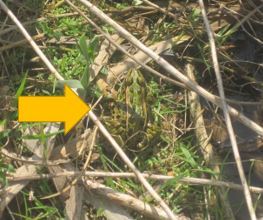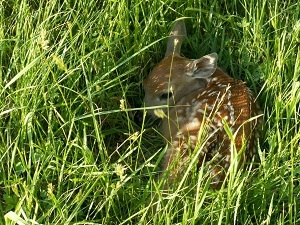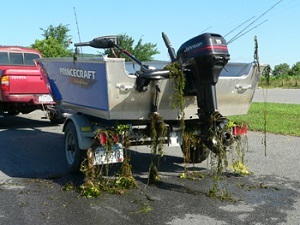Frog Populations Respond to Onondaga Lake Restoration
 The removal of pollution in and around Onondaga Lake continues to lead to recovery for many species within the lake. Prior to the cleanup, frog populations were lower. A major goal of the restoration plan was to improve breeding habitats for amphibians. This spring, frogs started to demonstrate their approval of these efforts. Leopard frogs (well-hidden in the photo to right) and their tadpoles, as well as toads, were discovered in the wetlands created next to the lake. The clean-up and restoration work undertaken by Honeywell was directed by DEC’s Division of Environmental Remediation and the Division of Fish and Wildlife. The removal of pollution in and around Onondaga Lake continues to lead to recovery for many species within the lake. Prior to the cleanup, frog populations were lower. A major goal of the restoration plan was to improve breeding habitats for amphibians. This spring, frogs started to demonstrate their approval of these efforts. Leopard frogs (well-hidden in the photo to right) and their tadpoles, as well as toads, were discovered in the wetlands created next to the lake. The clean-up and restoration work undertaken by Honeywell was directed by DEC’s Division of Environmental Remediation and the Division of Fish and Wildlife.
Photo by Tracy Smith.
Help Protect Young Wildlife When Managing Habitat
 In warm weather, fields and yards quickly become a jungle of wild flowers, grasses and other greenery. While those fields of green may be a chore to landowners, it provides habitat for many animals. Ground nesting birds use these areas to construct their nests and raise their young. Rabbits and white-tailed deer will also give birth in these dense grasses. In the first few weeks following birth, female deer will leave their fawns in secure places while they look for food. This can leave fawns susceptible to unexpected threats like lawn mowers and tractors. In warm weather, fields and yards quickly become a jungle of wild flowers, grasses and other greenery. While those fields of green may be a chore to landowners, it provides habitat for many animals. Ground nesting birds use these areas to construct their nests and raise their young. Rabbits and white-tailed deer will also give birth in these dense grasses. In the first few weeks following birth, female deer will leave their fawns in secure places while they look for food. This can leave fawns susceptible to unexpected threats like lawn mowers and tractors.
You can help by conducting a walkthrough before mowing, but a fawn’s camouflage and sit-and-stay behavior make it difficult to spot. It’s best to wait until later in the summer to conduct your first mowing to make sure that fawns, rabbits and birds have matured and are capable of escaping from mowers and tractors. Visit DEC's website to find more information about what to do when encountering fawns and other young wildlife.
Help “Stop the Spread” During Invasive Species Awareness Week
 The fifth annual Invasive Species Awareness Week (ISAW) campaign will be held July 8-14, 2018. This year, the ISAW theme is "What YOU can do to stop the spread!" The week-long campaign features several statewide events focused on invasive species, ranging from invasive species removal projects, guided hikes and paddling events, informational webinars, citizen science trainings, film screenings, and more. Visit the ISAW events page to learn more about how you can become involved. The fifth annual Invasive Species Awareness Week (ISAW) campaign will be held July 8-14, 2018. This year, the ISAW theme is "What YOU can do to stop the spread!" The week-long campaign features several statewide events focused on invasive species, ranging from invasive species removal projects, guided hikes and paddling events, informational webinars, citizen science trainings, film screenings, and more. Visit the ISAW events page to learn more about how you can become involved.
Can’t get out and help during invasive species awareness week? Here are a few other ways you can help stop the spread of destructive invasive species:
- Be sure to clean all plant material and mud from your boat and gear before leaving the boat launch. Dispose of materials in an aquatic invasive species disposal station if one is available.
- Select only native plants for use in your yards and gardens.
- Don't move firewood, and be aware of firewood regulations in your area. Moving firewood can contribute to the spread of forest pests.
- Clean boot treads and pant legs to remove plants and seed material after a hike to avoid spreading these to other sites.
|


 The
The  In warm weather, fields and yards quickly become a jungle of wild flowers, grasses and other greenery. While those fields of green may be a chore to landowners, it provides habitat for many animals. Ground nesting birds use these areas to construct their nests and raise their young. Rabbits and white-tailed deer will also give birth in these dense grasses. In the first few weeks following birth, female deer will leave their fawns in secure places while they look for food. This can leave fawns susceptible to unexpected threats like lawn mowers and tractors.
In warm weather, fields and yards quickly become a jungle of wild flowers, grasses and other greenery. While those fields of green may be a chore to landowners, it provides habitat for many animals. Ground nesting birds use these areas to construct their nests and raise their young. Rabbits and white-tailed deer will also give birth in these dense grasses. In the first few weeks following birth, female deer will leave their fawns in secure places while they look for food. This can leave fawns susceptible to unexpected threats like lawn mowers and tractors. The fifth annual
The fifth annual